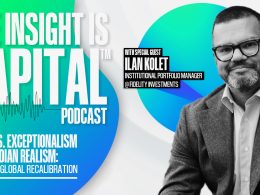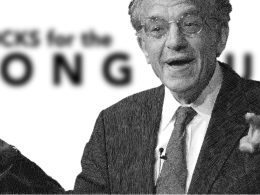Street smarts
by Jeffrey Saut, Chief Investment Strategist, Raymond James
Some people can have a lot of experience and still not have good judgement. Others can pull a great deal of value out of much less experience. That’s why some people have street smarts and others don’t. A person with street smarts is someone able to take strong action based on good judgement drawn from hard experience. For example, a novice trader once asked an old Wall Street pro why he had good judgement. “Well,” said the pro, “Good judgement comes from experience.” “Then where does experience come from?” asked the novice. “Experience comes from bad judgement,” was the pro’s answer. So you can say that good judgement comes from experience comes from bad judgement.
. . . Adapted from “Confessions of a Street Smart Manager,” by David Mahoney
Years ago we read a book that a Wall Street pro told us would give us good judgement by benefitting from the experiences of others who had suffered hard hits. The name of the book was “One Way Pockets.” It was first published in 1917. The author used the nom de plume of Don Guyon because he was associated with a brokerage firm having a sizeable business with the public and he had conducted an analytical study of orders executed for active public traders.
The results were “illuminating enough to afford corroborative evidence of general trading faults which persist to this day.” The study detected “bad” buying and “bad” selling, especially among active and speculative participants. It documented that the public “sells too soon, repurchases at higher prices, buys more after the market has turned down and finally liquidates on breaks… a true response in all similar Wall Street periods.”
For instance, the book showed that when a bull market begins the accounts under analysis would buy for value reasons; buy well, though very small. The stocks were originally bought for the longer term rather than for day-to-day trading purposes. But as prices moved higher participants were so scared by memories of the previous bear market, and so worried they would lose their profits, they sold. At this stage “the accounts showed scores of complete transactions, yielding profits of less than two points, liberally interspersed with losses.”
Then in the second phase, when accounts were convinced that the bull was for real and a higher market level was established, stocks were repurchased, usually at higher prices than where they had previously been sold. “At this stage larger profits were the rule; three, five, seven and even ten points were taken… the advance had become so extensive that several attempts were made to find the ‘top’ with short sales… the experiments were almost always disastrous.”
Finally, in the latter stage of the bull market the recently active and speculative accounts would tend not to over-trade or try to pick “tops,” but resolved to buy and hold. So many times previously they had “sold” only to see their stock dance higher, leaving them frustrated and angry. “The customer who months ago had been eager to take a profit on 100 shares of stock would not take ten points of profit on 1000 shares of the same stock now that it had doubled in price.” In fact, when the market finally broke down, even below where accounts bought their original stock, they bought more. They would not sell. The tendency of the trading element at this mature stage of the bull market was to buy breaks. The author concludes that their trading “methods had undergone a pronounced and obvious unintentional change with the progress of the bull market from one stage to another . . . a psychological phenomenon that causes the great majority to do the direct opposite of what they ought to do!” Conclusion: “The collective operations of the active speculative accounts must be wrong in principal… so the method that would prove profitable in the long run must be the reverse of that followed by the consistently unsuccessful.”
Not much has changed from 1917 to 2017, just the players, not the emotions of greed versus fear or supply versus demand. Like in the book “One Way Pockets,” we too have studied the psychological mindset changes participants go through over the course of a secular bull market. As Ray DeVoe notes, they are: 1) Aftershock and Rebuilding; 2) Guarded Optimism; 3) Enthusiasm; 4) Exuberance; 5) Unreality; and finally 6) Cold Water and Disillusionment. Clearly we are nowhere near “Enthusiasm, Exuberance, or Unreality.” We think investors’ mindset is currently at “Guarded Optimism.” And that “Guarded Optimism” continued last week as the D-J Industrial Average (INDU/20547.76) broke a two-week losing streak by gaining 0.5%. In last Monday’s report Andrew and I hinted that might just be the case when we wrote:
It should also be noted that our measurement of the stock market’s “internal energy” levels are almost back to a full charge, implying if the downside gets going there is enough energy for a decent move. If that is the case, the strongest “energy flows” should come early this week, suggesting the potential for a trading bottom late week. Also suggestive of a trading bottom are the Volatility Index (VIX/15.96), the CBOE Put/Call Ratio, and the sentiment readings.
Well, we didn’t get the perfect pattern last week, which would have been an early week whoosh to the downside into the long-targeted 2270 – 2280 level by the S&P 500 (SPX/2348.69). However, late last week we advised participants to get their “buy lists” ready because a rally may be in the cards. We still feel that way. Indeed, since being in cautionary mode from the first week in February our models took a decided turn for the better last week despite the backdrop of nasty geopolitical events, mixed economic reports, and some earnings misses. Our sense is that over the next few weeks the lack of “selling pressure” is going to allow stocks to attempt to lift. While we don’t think it will be a vigorous “lift,” it should still be a lift. Accordingly, we would urge you to sift through the stocks featured in these missives over the past few months that Andrew and I have suggested you put on your “watch lists” for potential purchase when the time was right. We think the time is finally right after the past nearly three months of “going nowhere” consolidation.
The call for this week: This week Andrew and I are in Orlando at the Raymond James National Conference where we will be seeing portfolio managers, financial advisors, and giving a keynote address. Hopefully the equity markets will give an “upside address” of their own in our absence. To that point, it is worth mentioning that there has been an “internal correction” going on for the past few months, leaving only 25% of the S&P 500 stocks above their respective 10-day moving averages (DMAs). Meanwhile, 75% of the S&P 500 stocks reside above their 200-DMAs, which is evidence that the primary trend of the equity market is still “up.” Plainly, Dow Theory agrees with that! Amazingly, the equity markets have held up pretty well despite the talk of thermonuclear war and ICBMs, implying this has been a three-month bullish upside consolidation pattern. That is very much like the 18-month bullish consolidation chart pattern that occurred between November 2014 and July 2016, where the Bear Boos told us it was a major top, yet we remained steadfastly bullish. Ladies and gents, this is a secular bull market with years left to run. In addition to the stocks featured in our reports, the only sector that is “overbought” in the short-term is Consumer Discretionary (see chart 1 on page 3). And over the weekend Macron (the globalist) has a lead over Le Pen (the nationalist), leaving the preopening S&P 500 futures up some 26 points at 5:00 a.m. as we watch the sun rise in Orlando at the RJFS National Conference. As we said last week, “Ready your buy lists!”
















